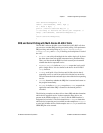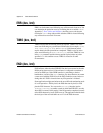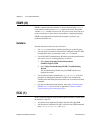
Appendix A GPIB Basics
© National Instruments Corporation A-3 NI-488.2 User Manual for Windows
Handshake Lines
Three hardware handshake lines asynchronously control the transfer of
message bytes between devices. This process is a three-wire interlocked
handshake, and it guarantees that devices send and receive message bytes
on the data lines without transmission error. Table A-1 summarizes the
GPIB handshake lines.
Interface Management Lines
Five hardware lines manage the flow of information across the bus.
Table A-2 summarizes the GPIB interface management lines.
Table A-1.
GPIB Handshake Lines
Line Description
NRFD
(not ready for data)
Listening device is ready/not ready to receive a
message byte. Also used by the Talker to signal
high-speed GPIB transfers.
NDAC
(not data accepted)
Listening device has/has not accepted a message
byte.
DAV
(data valid)
Talking device indicates signals on data lines are
stable (valid) data.
Table A-2.
GPIB Interface Management Lines
Line Description
AT N
(attention)
Controller drives ATN true when it sends
commands and false when it sends data messages.
IFC
(interface clear)
System Controller drives the IFC line to initialize
the bus and make itself CIC.
REN
(remote enable)
System Controller drives the REN line to place
devices in remote or local program mode.
SRQ
(service request)
Any device can drive the SRQ line to
asynchronously request service from the Controller.
EOI
(end or identify)
Talker uses the EOI line to mark the end of a data
message. Controller uses the EOI line when it
conducts a parallel poll.


















